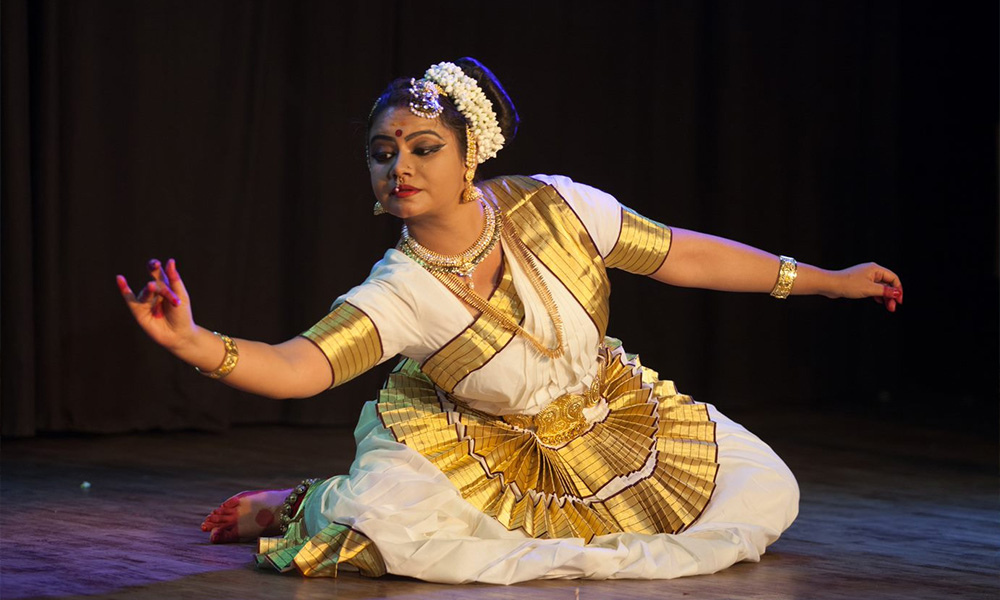In addition to the temples that illustrate the architectural elegance of ancient India, Mahabalipuram, a small town in Tamil Nadu, is also renowned for its vivacious Mahabalipuram dance festival. This annual festival which takes place in the months of December and January features the popular Indian classical dances including Odissi, Mohiniattam, Kathakali, Kuchipudi, and Bharatnatyam.
In addition to the classical dances, the festival also presents folk dances. This artistic ceremony is patronized by the Tamil Nadu Tourism Department and invites dancers, troupes, artists and illustrious dance gurus.
During the four-week long festival, a minimum of 2 performances are presented every night and the entry is gratis for everyone. This amazing dance festival has emerged as one of the preeminent cultural interests of the southern state of the country of India.
Arjuna’s penitence, a bass-relief carved on the face of two humongous adjoining rocks, in Mamallapuram, has been designated as the venue for the Mahabalipuram dance festival. The marvellous scenery offered by the Pallava Rock Sculptures as the backdrop magnifies the overall charm of the festival and also embellishes it with an artistic touch, which is honourably indigenous to the ancient Indian culture.
There is an open-air stage where the artists are called upon to perform. The open house-style ambience offers the ideal disposition for the dancers to render a breathtaking performance. This open-air stage, which was brought into existence around thirteen centuries ago, is incredibly enthralling and features imposing rock sculptures that can be traced back to the Pallavas. Art forms and Indian classical dances are the major features of the festival. If you happen to be an admirer of performing art, you would not want to miss this great event that is held only once every year. Owing to the exquisite beauty of South India, you are bound to have experience unforgettable evenings that never cease to amaze the tourists who visit the place. You will get a chance to witness the alluring classical dances with a tinge of contemporaneity.
Besides the dance festival, the old city of Mamallapuram is momentous on its own terms. The shore temple, which is located at a distance of 58 kilometers from Chennai, the capital city of Tamil Nadu, captivates tourists who visit the state from different parts of the country and the world to revel in the dance festival.
The temple is distinguished for its striking architectural charm, with colossal rock sculptures. The ancient town has been transformed into a delightful tourist destination with the fusion of the ancient 7th and 8th century Pallava temples, carvings and fabulous beaches.
While the Indian classical dance guild arrives at Mamallapuram during this time to watch the bewitching performances, the festival is also a chief tourist destination as it also includes visitors from across the globe who visit the city to get a taste of the ancient Hindu traditions and culture.
Like most Indian festivals, the Mahabalipuram dance festival is also lively. It exhibits classical music and dance forms, which have been upheld over the generations. Gear yourself up for the festival as you make a plan for your tour to India.
Timing
The Mamallapuram Dance Festival takes place during the months of December and January. The festival usually begins on the 25th of December and continues until the end of January, with daily performances scheduled in the evenings.
Venue
The UNESCO World Heritage Site of Mamallapuram provides a stunning backdrop for the dance festival. The venue for the performances is the open-air stage, known as the "Arjuna's Penance" or "Descent of the Ganges" rock bas-relief, which is a magnificent piece of ancient Indian art.
Dance Forms
The festival brings together renowned dancers and dance troupes from all over India to showcase a diverse range of classical dance forms. Some of the prominent dance styles featured in the festival include:
Bharatanatyam: A classical dance form from Tamil Nadu, Bharatanatyam is characterized by intricate footwork, expressive gestures, and elegant postures.
Kathak: Originating from North India, Kathak is known for its fast footwork, storytelling, and graceful movements.
Odissi: Hailing from the state of Odisha, Odissi is a graceful dance form that focuses on expressions, fluid movements, and poses.
Kuchipudi: A traditional dance form from Andhra Pradesh, Kuchipudi features a combination of storytelling, fast footwork, and dramatic expressions.
Mohiniyattam: Mohiniyattam is a classical dance form from Kerala, characterized by its slow, graceful movements and delicate expressions.
Manipuri: Manipuri dance originates from the northeastern state of Manipur and is known for its lyrical and spiritual elements.
Kathakali: Although not a part of the festival's regular lineup, Kathakali occasionally makes appearances. This classical dance form from Kerala features elaborate makeup, costumes, and facial expressions to portray mythological stories.
Cultural Experience
The Mamallapuram Dance Festival offers a wonderful opportunity to experience the cultural diversity of India through its classical dance forms. The performances take place against the backdrop of ancient monuments and sculptures, adding to the ambiance and creating a mesmerizing experience for both local spectators and tourists.
If you plan to attend the Mamallapuram Dance Festival, make sure to check the schedule in advance and arrive early to secure a good spot to enjoy the performances. The festival is a celebration of India's artistic heritage and a true delight for anyone interested in classical dance and Indian culture.
